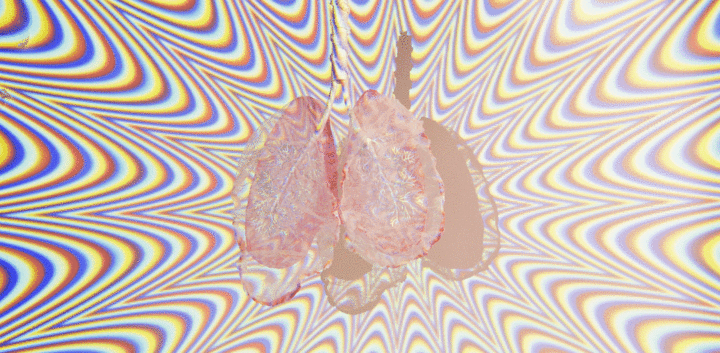
The Business of Breathing
By Kelly Conaboy
Images by Party of One
When asked what he does first thing in the morning, Marcel Duchamp reportedly replied, “Breathe.” In addition to being one of the patron saints of the Madness issue, Duchamp was right on trend: Breathing classes, workshops, therapies, and retreats are on the rise, and there's lots of money being made. Kelly Conaboy inhaled.
• • •
Do you breathe? I mean: Do you breathe?
Your hippie friend says holotropic breathing is the new ayahuasca. Your Goop-y friend does breath exercises in the salt room at their spa. Your super-scheduled friend has a breathing app on her phone. And your friend who owns the self-improvement aisle at the bookstore has been going to breathing therapy for months.
Like it did with yoga in the ’90s, Western culture has opened its mind to breathing, née pranayama, as a tool to wield against anxiety, stress, and physical ailments, as well as a way to trip the fuck out. The practice of mindful breathing has traveled through time from the world’s oldest living religion, Hinduism, to the world’s newest religion, Wellness, and counts Gwyneth Paltrow, Karlie Kloss, Oprah, Emma Watson, and the New York Knicks among its practitioners. It is often dubbed as a quick way to relieve stress and, indeed, “the new yoga!”
The association with capital-W Wellness is unfortunate. Though the Wellness movement’s goals may be pure (and that’s giving it the benefit of the doubt), the path it takes to secular enlightenment is often through a field of toxin-filled money landmines and junk science, which can give one a sense of knee-jerk, often correctly cynical, disapproval. Because the concept of Wellness stretches so broadly—natural makeup is Wellness, and so is cultivating a sense of inner peace, and so is salad—it has an association with luxury that can sometimes feel discordant (like, uh, luxury meditation).

And when the luxury peddled at the Church of Wellness is breathing, the absurdity is hard to ignore. Breathing is one of life’s simplest pleasures and can be done anywhere, anytime, at little-to-no cost—go ahead, try it now. But those who are looking for something a little more high-end can get their kicks with a four-day breathing retreat in a beautiful poolside villa in Lanzarote (one of the Canary Islands), or private $550 breathing classes on the Upper East Side of Manhattan; there was even, of course, a dedicated breathing room and breathwork sessions offered at the New York City Goop summit.
Is paying someone to show you how to breathe ridiculous or a surprisingly reasonable way to grow healthier? I live in New York City, a Western Wellness capital rivaled only by L.A. And like everyone else with access to Twitter, I’d love to feel more balanced, calm, and free from sickness and symptoms. And so, with credit card in hand, I set out to learn firsthand: Is breathwork bullshit?
Heartened by the cosign from a medical professional, I decided to take the next monetary step toward breath perfection.
My first foray into capitalistic respiration cost less than a green juice. For $3.99, I obtained a breathing app from the man who runs that Lanzarote retreat I mentioned earlier, “BreathGuru” Alan Dolan. The eponymous program comprises two guided breathing sessions and a few videos featuring the guru himself. I’d rather never watch a video, but the guided breathing sessions are nice. It’s pleasant to lie down and breathe for either 10 or 30 minutes, which are the two options. Nothing much is demanded of you, and breathing is a clinically proven stress reliever (you can read about this March 2017 Stanford University study on breathing’s positive effects on emotion, if you’d like). The app is more expensive than the typical cost of breathing, but you also get to hear New Age music and a man breathing with you—maybe you like that.
The BreathGuru’s claims don’t stop at stress relief, however. “Degenerative diseases, cardiac problems, and cancer are linked to oxidative stress and cellular free-radical damage, and breath is a key factor in prevention,” Dolan said in a Net-A-Porter article on the power of breathing. “When the breath is out of kilter, your body’s fight-or-flight mode is heightened. But get the breath right and cells are flooded with oxygen, so the body begins to recalibrate and release toxins.”
It always strikes me as particularly insidious when cancer is brought up in the promotional material of Wellness salespeople. But I am trying to breathe and remain relaxed, so I spoke to Geoffrey Chupp, M.D., a pulmonary medicine professor at Yale University and director at the Yale Center for Asthma and Airways Disease, about whether or not all this stuff was bullshit.
“There’s a desire to say that if you breathe right, you’re going to have less cancer, but it’s a more complex relationship,” he said. “What’s pretty clear is that having healthy lungs contributes to having a healthy body. And having healthy lungs means that you have to use them, and you have to use them properly, and you have to take care of them. I think the link is that breathing exercises, the fads and the traditional ones, are ways of keeping your lungs healthy.”

So the purported health payoffs aren’t just a marketing ploy? “There’s probably pretty good data out there supporting the benefits of [breathing exercises] for a lot of diseases,” he said, “including psychiatric diseases and anxiety, cancer, heart attacks, and most important in my field is asthma.”
Dr. Chupp told me about a study, published in the Journal of Asthma in 2011, on the benefits of yoga and breathing exercises on asthma; it was inconclusive, but showed in some cases that patients had better asthma control if they exercised. The connection between your breathing and your brain is well known in both sickness and in health, he explained—breathing has a chemical effect on your blood, and a chemical and hormonal effect on your brain. When you’re anxious, you breathe quickly; when you breathe deeply, you can decrease anxiety.
“The normal response to exercise is to bronchodilate,” meaning to increase airflow to the lungs, “so I think a lot of these [breathing exercises] are basically facilitating that and ensuring that your airways are being ventilated,” he said. In deep (vs. shallow) breathing, you fill your lungs to their full capacity, so you’re trading a larger amount of carbon dioxide for oxygen with which to oxygenate the blood. This is proven to ease anxiety, and sounds good to me.
Heartened by the cosign from a medical professional, I decided to take the next monetary step toward breath perfection: I visited MNDFL—an extremely good-looking meditation studio chain with three NYC locations—for its $25 BREATH class. “Feeling stressed or anxious?” MNDFL’s website asks. Yes! I’m so glad you asked. “This is a good class for you. Learn to focus on your breathing in order to become more present. Work with the breath in a way that allows you to be more calm and not get too lost in your own head.”
MNDFL’s space—wooden, bright white, light-flooded—is dotted with large, leafy green plants. It faces a floor-to-ceiling window that frames a large outdoor moss version of the MNDFL logo. It’s a calm, beautiful, perfectly branded breathing space, and I’d booked my spot online, which was very convenient. I sat cross-legged on a cushion early in the morning surrounded mostly by beautiful women in casual business attire. We breathed in a fairly nonstructured way, and listened to a very soothing woman talk to us about our breath and our thoughts. Periodically, she would give us tips: Focus on your breath; give a bit of attention to nagging thoughts and then let them go. It was essentially a meditation class, and it was extremely fine.
Here’s the thing about mentally therapeutic techniques, such as breathwork: Shilling them without knowing much about the mind of the client can be tricky. I spoke with Patricia L. Gerbarg, M.D., assistant clinical professor in psychiatry at New York Medical College and part of the husband-wife team behind Breath Body Mind (an evidence-based breathwork initiative that aims to “integrate the best of conventional and natural treatments”), about what she sees as the potential missteps of mass-distributed holistic mental care.
Mostly, she said, the issue stems from not understanding or explaining potential side effects. “We see very famous people recommending their brand of a breathing practice, and that’s going to be fine for 95% of people,” she said. “But we know some people will have a bad reaction. Anyone can take an idea and put a little twist on it and make it sound like their own special thing, but if they don’t really understand how that affects the system, physically and psychologically, then their little twist may add something that’s not good for people.”
But the mass-distributed breathwork is growing, and with it research, evidence, and acceptance. “Most recently, the National Veterans Association made the decision that veteran treatment facilities should offer mind-body practices,” Dr. Gerbarg said. “They’re open to it, and they’re now officially offering it in a way that incentivizes VA facilities to find people to teach these kinds of programs.”
One solution—a pricey one, of course—is one-on-one breath sessions. These are offered in places ranging from yoga studios to well-appointed lofts to your very own apartment, usually with a Skype option available for out-of-town breathing. The one I tried, a $180, 60-minute session called Rebirthing, was a surprisingly wonderful experience. It didn’t start out that way; the night before, I had to fill out a very insane 38-question form, which asked what time I was born, what my most negative thoughts about relationships are, and what I was like as a child. At the start of the session, the breathworker and I went over my answers together, which was slightly uncomfortable.

But afterward, the very kind breathworker just watched me breathe while I lay under a blanket on a little massage table—big deep breath in, big deep breath out, big deep breath in, big deep breath out—for an hour. She told me my hands and face and legs might get numb and rigid during the breathing, and, wow, they did. It was very odd. But I did not suffer a breakdown, which I was nervous about. I also did not invent a memory of being involved in a Satanic sex cult, which I was also nervous about. After, I felt briefly energized and slightly happier, and she told me I was a very good breather, which I include not as a brag, but as a fact.
One man said he could feel “toxin after toxin” leaving his body, and one woman said she felt herself going back to the womb.
Of all the Wellness-centered breathwork offerings out there, holotropic breathing is one of the most, well, out-there. The technique was engineered in the ’70s by Stanislav Grof, M.D., and his wife, Christina, psychotherapists researching the effects of LSD. The practice, meant to mirror LSD’s effects, is done by inhaling and exhaling quickly—essentially mildly hyperventilating—while lying on your back, typically for about three hours, and usually to a soundtrack of meditative music. The trippy experience is practiced in the name of accessing otherwise inaccessible parts of the psyche, letting go of past trauma, and decreasing anxiety.
I asked Dr. Chupp what happens in your body when you do this, mostly because I was afraid I might die while trying it. “What you’re probably doing is getting rid of carbon dioxide, so you’re changing the acid-base balance in your body,” he said. According to Google just now, the acid-base balance is based on the levels of carbon dioxide (an acid) and bicarbonate (a base) in the blood. “That would need to be studied pretty scientifically, at almost a molecular level, to understand what the effects are,” he added.

“For people who are looking to have some sort of very intense experience, this can provide it,” Dr. Gerbarg explained. “People who are very psychologically healthy and well put together can tolerate it fine.” But holotropic and even rebirth breathwork can be upsetting—even destabilizing—for those who aren’t as psychologically sound. “It’s creating an altered mental state. So people used to do this as a way to have trips and other psychological experiences,” she said. She specified that she wasn’t criticizing the techniques, because they can do a lot of good, “but I do believe that some of those practices are not safe for the general public in the way that we use them.”
She advised practicing these techniques—if one must—one-on-one with an experienced breathworker, rather than in a large group.
But I’d already signed up for my group holotropic session, so I blew off the suggestion (sorry, Patricia!) and found myself in a group of Rag & Bone–looking people in a second-floor loft space in Lower Manhattan. The class took place at Woom, and luckily, it was not a nightmarishly bad experience in the ways I feared most (Satanic sex cult recovered memory). The holotropic breathwork was part of a Friday night five-part sound meditation session ($40) and lasted not for the standard three hours, but for 20 minutes. The room was full of very beautiful people in loose clothing who were hanging all over one another before the session began, which made me realize this was perhaps a thing people did before they had sex. (I was alone.)
For the session, everyone lay on blankets on the ground (extremely uncomfortable because the five-part session lasted two and a half hours, but I’m not complaining—I would never complain) and put blindfolds on that said “LOOK INSIDE” on the inside part. During the breathing practice, the instructor moved around the space banging a gong faster and faster, to the tempo of our breaths. The sound of everyone hyperventilating together was, I must admit, to my ear (and I say this without judgment): extremely not pleasing. About 30 men and women all going [inhale] [HUUUUUHHHHH], [inhale] [HUUUUUHHHHH], [inhale] [HUUUUUHHHHH] for 20 minutes is simply not something I am naturally inclined to enjoy, and that’s fine. The breathing was at a much faster pace than the breathing during rebirthing, and while I got a bit of the same numbness, I got none of the pleasant feelings and also chest pain.
But I am only speaking for myself. In the final part of the session, we were invited to share our experiences: One man said he could feel “toxin after toxin” leaving his body, and one woman said she felt herself going back to the womb. (Remarkably, she did not add, “Like you will be going back to the Woom, every week, for more meditation,” so I don’t believe she was an advertising plant.) I am happy for them, and I genuinely hope they did not feel my light negativity.
I don’t see breathing’s rise in popularity as a bad thing, though that is admittedly an odd sentence to have to write. “I think it’s gaining popularity because it makes people feel better,” Dr. Chupp told me. “There doesn’t have to be data for things to become popular. It just has to make people feel good.” He added that he believes if more studies were done, “and they probably should be,” they’d attest to breathing’s power.
Basically, breathing is good for you, and people deserve to practice absolutely anything within the realm of decency that helps them feel even the slightest bit better. But it’s important to take a moment to pause and consider what you’re buying, why you’re buying it, if you should be buying it, and from whom you’re buying it. Slow down; be mindful of your mindful breathing. Take a deep breath. Exhale. [HUUUUUHHHHH].
KELLY CONABOY is a writer who lives in Brooklyn.
PARTY OF ONE is the collaborative studio of Melissa Deckert and Nicole Licht.


